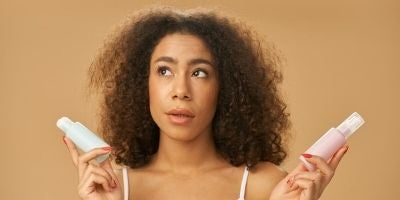By Boma Brown-West. This blog was originally posted on EDF+Business.
The U.S. beauty industry is under scrutiny for its use of toxic chemicals. Consumers, particularly Gen Z, are concerned about the ingredients in their beauty and personal care products and the impact they are having on their health, and are pushing the industry to clean up its act.
Companies are responding by trumpeting clean beauty commitments. From major retailers to boutique brands, the number of companies marketing “cleaner” alternatives is exploding. Today, the clean beauty industry is estimated to reach $11 billion by 2027.
While it’s encouraging to see companies work to fill the current regulatory void on safe beauty products, the majority of clean efforts are focused only on products marketed to white women. As a result, women of color don’t have the same access to safer beauty options, and are therefore facing alarming and disproportionate exposure to toxic chemicals.
Retailers and product manufacturers need to champion clean beauty justice, which will put racial equity front-and-center in their efforts to provide consumers of color with safer products.
A booming market with a toxic disparity
The U.S. is the largest cosmetic market in the world and valued at approximately $39 billion.
The average woman uses 16 products on her face alone before leaving the house in the morning. Women of color purchase nine times the amount of beauty products as white women, which is fueling growth of the multicultural beauty market.
Many beauty brands are providing more makeup options for customers with darker complexions. Estée Lauder launched its Double Wear Matte Powder foundation in 41 shades.

At the same time we’re seeing growth in products marketed to women of color, we’re also seeing the rise in “clean” beauty. Consumers, concerned with the health impacts of conventional makeup, are turning to clean beauty as a way to ensure their products are safe. The trend #cleanbeauty now has 207 million views on Tik Tok and 4.1 million posts on Instagram.
But for the most part, products for women of color are being left out of the clean conversation. This is despite the fact that non-white women have a higher concentration of toxic beauty ingredients in their bodies.
African American women have nearly two times higher levels of diethyl phthalate, a common ingredient used in beauty products, in their bodies compared to non-Hispanic white women. Some of the most problematic products, including hair straighteners and skin lighteners, are also emblems of an industry that has historically promoted eurocentric beauty norms.
Brands and retailers that are either creating a clean beauty program, or strengthening already-existing “clean” shops and labels, have both an opportunity and a responsibility to ensure that clean products are available, accessible and affordable for every single customer, regardless of race.
Creating a safer and more equitable marketplace
As outlined in our new framework, “clean” should describe beauty and personal care products that are made with the safest possible ingredients and have the lowest possible environmental impacts that the market can offer today.
As companies prioritize ingredient safety, they can — and must — commit to advancing racial equity, what we call Clean Beauty Justice, by:
- Removing toxic ingredients in personal care products marketed to women of color. This includes commonly used ingredients such as phthalates, parabens, benzophenone, oxybenzone, placenta, and diethanolamine or DEA. Prioritize reformulation of products, such as hair moisturizers and certain foundations, geared towards curly or coily hair and darker skin tones.
- Using only verified safer ingredients in personal care products marketed to women of color. Set the expectation with suppliers that they need to demonstrate how their replacement ingredients are safer. For example, point to third-party chemical hazard assessments, via services such as ChemForward, which demonstrate that new ingredients present lower hazards.
- Making it easier for customers to find safer personal care products on the shelf and online. Prominently display clean beauty products for women of color and the criteria these products met to receive their designation. Ensure full ingredient listings by product. Avoid using vague claims like “chemical-free”, “toxin-free”, and “preservative-free” to steer clear of greenwashing.
Everyone deserves the same access to safer beauty products. It’s time companies make that happen.









